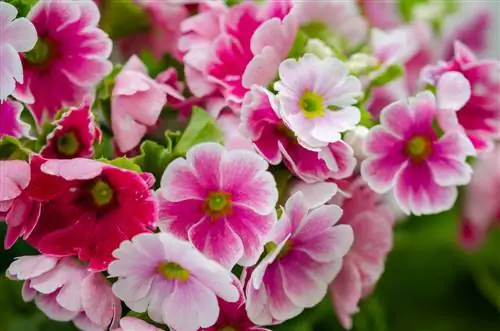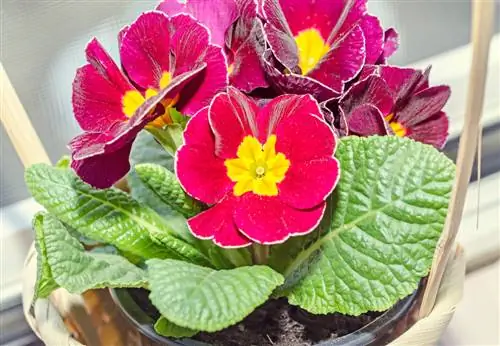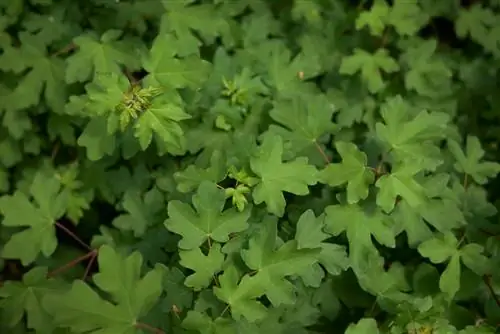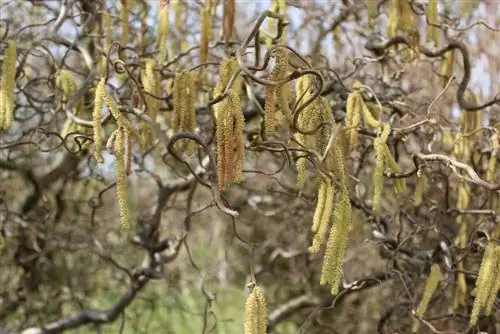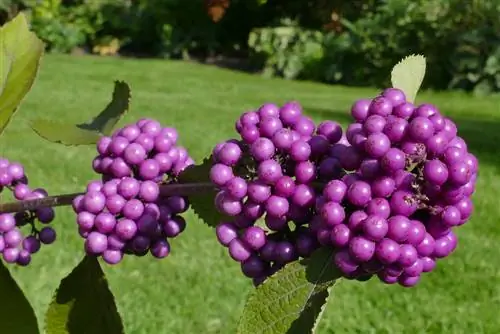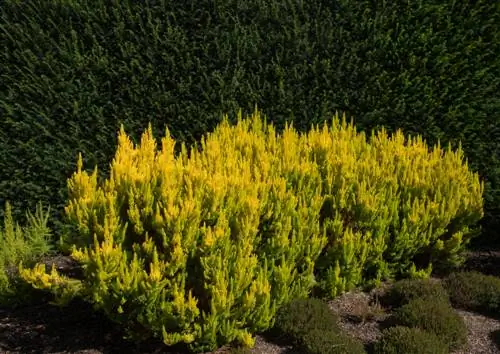- Author admin [email protected].
- Public 2023-12-16 16:46.
- Last modified 2025-01-23 11:22.
Read a commented primrose profile here with explanations of the flowers, leaves and winter hardiness. How to plant Primula obconica correctly. Tips worth reading about perfect cup primrose care.
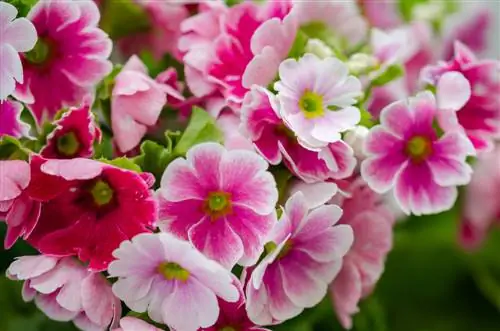
How do I properly care for a cup primrose?
The cup primrose (Primula obconica) is a perennial, non-hardy houseplant with lush flowers in various colors. It prefers nutrient-rich, loose potting soil, constant temperatures of around 15° to 18° C and bright to partially shaded locations without direct sunlight.
Profile
- Scientific name: Primula obconica
- Family: Primrose family (Primulaceae)
- Origin: Central and Southern China
- Growth type: Perennial
- Growth height: 10 cm to 30 cm
- Leaf: evergreen
- Flower: Umbel, fivefold
- Flowering period: January to June
- Fruit: Capsule
- Toxicity: poisonous
- Winter hardiness: not hardy
- Use: indoor greenery, summer balcony
Growth
The cup primrose (Primula obconica) is a perennial, herbaceous flowering plant that is highly valued in this country as an opulent pot flower. With their lush, nostalgic flowers, cup primroses have been among the most beautiful houseplants for more than 100 years. In contrast to its numerous conspecifics, the Asian primrose species delights with a tireless flowering marathon from late winter to summer. You can read more about growth properties worth knowing here:
- Growth habit: evergreen, basal leaf rosette, upright inflorescence shafts with spherical, flower-rich umbels.
- Growth height: 10 cm to 30 cm.
- Special feature: all parts of the plant are fluffy and delicately hairy.
- Gardenically interesting properties: easy to care for, sensitive to frost, poisonous, ostentatious abundance of flowers, flowering period for months, perennial.
Video: Beautiful flowers for the windowsill - admire cup primrose up close
Bloom
Early in the year, the cup primrose lives up to its Latin name “Primula” for “the first” and sets off its colorful flower fireworks display. Worth seeing flowers unfold with these characteristics:
- Inflorescence: spherical umbel with up to 15 individual flowers on up to 25 mm long, hairy stems.
- Single flower: five-petaled, cup-shaped (hence the name cup primrose), delicately hairy.
- Flower colors: white, yellow, pink, red, blue, violet, lavender or salmon in a variety of shades.
- Flower ecology: hermaphrodite with styles of different lengths.
When a cup primrose spends the summer outside, bees, bumblebees and butterflies take care of the pollination. The fertilized flowers become capsule fruits with up to 100 seeds. Primula obconica seeds are light germinators.
Leaf
Decorative plus point before, during and after the lush flowering period is a rosette worth seeing with these leaf characteristics:
- Leaf shape: ovoid-rounded to oblong on 1.5 cm to 14 cm long, hairy stems.
- Leaf edge: smooth, curved, slightly curved.
- Leaf color: evergreen, dark green.
- Leaf size: 3 cm to 14 cm long, 2.5 cm to 11 cm wide.
- Texture: fleshy-strong, underside hairless, upper side finely hairy
Winter hardiness
The cup primrose (Primula obconica) is not hardy. The minimum temperature is around 10° Celsius. In this respect, the Asian flower beauty differs from frost-hardy European primrose species, such as the cowslip (Primula veris) or the cowslip (Primula elatior).
Excursus
Toxic to humans and animals
The cup primrose owes its unflattering common name, poison primrose, to its hairy stems, leaves and flowers. The delicate glandular hairs contain the toxic secretion primin. Even light skin contact can trigger a persistent and painful allergy. If birds, cats or small dogs nibble on cup primroses, there is a risk of serious or fatal poisoning. For family households with children and pets, primrose without primin is available in numerous, beautiful varieties, for example from the “Touch me” series.
Planting cup primrose
You can buy flowering cup primroses from specialist retailers from January for a price of around 2.99 euros. Planting is easy and inexpensive after sowing on the windowsill, in the winter garden or heated greenhouse. You can find out where and how to plant Primula obconica correctly here:
Sowing
Ripe capsule fruits of a cup primrose contain numerous, germinating seeds. With the help of self-harvested seeds, you can grow a whole flock of beautiful potted flowers for free. The following instructions explain everything important about seed harvesting and sowing:
- Put on gloves.
- Cut off brown capsule fruits to remove the seeds.
- Store seeds in a dry and dark place in a screw-top jar until February.
- At the beginning of February, fill a seed tray with seed soil and moisten it.
- Sprinkle seeds thinly.
- Press the light germinator on with a wooden board, do not over-sift.
- Cover the seed tray with a transparent hood.
- In a bright location at 12° to 15° Celsius, ventilate daily and keep constantly moist.
- Remove the cover after germination (2 to 3 weeks).
- Prick out seedlings into individual pots after about 6 to 8 weeks.
Please note: In contrast to European primrose species, cup primrose seeds are not cold germinators, but normal germinators.
Substrate
The cup primrose prefers to extend its roots in nutrient-rich, loose, permeable potting soil. It is recommended to add expanded clay or lava granules so that the soil does not become compacted with frequent watering. Indoor gardeners who are close to nature use potting soil without added peat.
Planting instructions
How to plant a cup primrose correctly:
- Place the root ball in soft, room temperature water in the growing or purchasing container.
- Cover the bottom of the pot with expanded clay or pottery shards as drainage against waterlogging.
- Fill the substrate up to half the height of the pot and form a depression in it.
- Place the potted, water-soaked cup primrose in the middle of the hollow.
- Fill in the remaining substrate around the root ball.
- Press down the soil and water thoroughly in lime-free water.
Because a cup primrose is watered frequently, a finger-width watering edge is recommended.
Location
The cup primrose thanks these location conditions with a lush display of flowers:
- In a bright to partially shaded place without direct sunlight.
- Ideally at constant temperatures around 15° to 18° Celsius for a long flowering period.
- From May to September, preferably outside in protected partial shade.
If the thermometer climbs above the 18° mark, regular spraying with lime-free water will allow the cup primrose to bloom longer.
Care for cup primrose
Cup primroses are easy to care for. A balanced water supply is important because the primrose does not tolerate dryness or waterlogging. The flowering time determines the correct supply of nutrients. A winter rest period is beneficial for the opulent flowers. Proper cutting, repotting and oversummering set the stage for a second flowering season. You can read the best care tips for Primula obconica here:
Don’t forget gloves
Before you come into close contact with delicately hairy cup primroses during care work, please protect yourself from the dreaded primrose dermatitis with gloves.
Pouring
- The cup primrose is watered regularly and sprayed with lime-free water.
- The substrate must neither dry out nor become waterlogged.
- Collected, filtered rainwater or stale tap water are suitable as irrigation water.
Fertilize
- When cup primroses are blooming: fertilize every two weeks with a phosphorus-rich liquid fertilizer (€8.00 at Amazon).
- If Primula obconica is not flowering: fertilize at half concentration every six to eight weeks.
Wintering
- Put away cup primrose from temperatures around 10° Celsius.
- Overwinter potted plant brightly and coolly at 15° to 18° Celsius.
- Watering more sparingly without letting the root ball dry out.
- Fertilize once or twice until the flowering period begins.
- Do not spray at temperatures below 18° Celsius.
Oversummer
Although the cup primrose thrives perennial, the beautiful pot flower is usually cultivated as an annual. With a simple measure you can coax another period of bloom from the floral piece of jewelry. This is how it works:
- Repot primrose after flowering.
- Ideally place on a balcony or terrace.
- Alternatively, plant the primrose in a semi-shady location in the garden.
- Dig up in early autumn, pot up and put away in the recommended winter quarters.
Cutting
- Clean out wilted flowers as soon as possible for an extra long flowering period.
- Alternatively, cut off stems with spent umbels at the base using disinfected scissors.
Diseases, pests, care errors
With its poisonous glandular hairs, the cup primrose keeps pests and diseases at bay. The Chinese primrose is not immune to neglect in care. The following table informs you about common malfunctions, lists typical causes and gives tips for effective countermeasures:
| malicious image | Cause | Countermeasure |
|---|---|---|
| Yellow leaves | hard watering water | repotting, watering with lime-free water |
| Brown, limp leaves | Waterlogging | repot, water more sparingly from now on |
| Gray Mushroom Lawn | Grey mold (Botrytis cinerea) | Quarantine, cut off the infected, dust with rock dust |
| Green, black pests | Aphidoidea | fight with soap-spirit solution |
| Pathetic flowers | location too warm | set up at 15° to 18° Celsius |
Popular varieties
These beautiful cup primrose varieties decorate windowsills and summer balconies with colorful flowers:
- Touch me Blue: magnificent, blue-flowered cup primrose without primin, ideal for use as a houseplant in the family household.
- Touch me Red: red flowering Primula obconica without primin, harmonizes colorfully with Touch me Blue.
- Sweet Kisses: Cup primrose variety family with romantic ruffled flowers in multi-faceted colors.
- Twilly Salmon Spring: Rarity with salmon pink-white flowers that do not cause annoying itching when in contact with the skin.
- Galaxy: boasts purple-red, white-edged flowers over dark green leaves from February onwards.
FAQ
Is the cup primrose poisonous?
All above-ground parts of a cup primrose are delicately hairy. Primin is found in these glandular hairs. This toxic substance causes annoying itching and even stubborn allergic reactions when it comes into contact with the skin. Consuming poison primrose is particularly dangerous for birds, cats, small dogs and other pets. There is a risk of nausea, vomiting, stomach cramps or, in the worst case, circulatory collapse and cardiac arrest. By purchasing a primrose without Primin, you can reliably avoid this risk.
Are cup primroses hardy?
Cup primroses are not hardy. The minimum temperature is 5° to 10° Celsius. In this respect, the Chinese primrose species differs from its hardy, Central European counterparts, such as the well-known cowslips (Primula veris) and auricles (Primula auricula).
When can a cup primrose go outside?
The cup primrose is sensitive to frost. A longer stay at temperatures below 10° Celsius reliably kills the Chinese primrose species. For this reason, you should only put a Primula obconica outside after the Ice Saints in mid-May.
Does the cup primrose thrive as a perennial?
In its native Asian regions, the cup primrose thrives perennially. Because Primula obconica is not hardy in this country, the pretty pot flower is usually disposed of after it has bloomed. A repeated change of location after the flowering period is advantageous for multi-year cultivation in the Central European climate. The cup primrose should stay outside from May to September. From October onwards, a bright, cool winter quarter with 10° to 15° Celsius is recommended for a strong flowering impulse.

